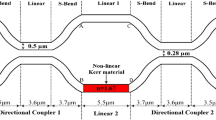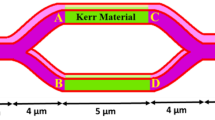Abstract
All optical integrated circuits have great application in high-speed computing and information processing to overcome the limitation of conventional electronics. In this work, a novel design of all optical universal gates using optical Kerr-effect and optical bistability of a plasmonics-based Mach-Zehnder interferometer (MZI) has been proposed. A MZI is capable for switching of light which depends on the intensities of optical input signal. The study of device is carried out using finite-difference-time-domain (FDTD) method and verified using MATLAB simulation.










Similar content being viewed by others
References
Cotter D, Manning RJ, Blow KJ, Ellis AD, Kelly AE, Nesset D, Phillips ID, Poustie AJ, Rogers DC (1999) Nonlinear optics for high-speed digital information processing. Science 286:1523–1528
Wu YD (2004) Nonlinear all-optical switching device by using the spatial soliton collision. Fiber and Integrated Optics 23:387–404
Kumar S, Bisht A, Singh G, Sharma S, Amphawan A (2015) Proposed new approach to the design of universal logic gates using the electro-optic effect in Mach Zehnder interferometers. Appl Opt 54:8479–8484
Sribashyam S, Ramachandran M, Prince S, Ravi BR (2015) Design of full-adder and subtractor based on MZI-SOA. IEEE proc., signal processing and communication engineering system 14984708, 19-21
J. Takahara, S. Yamagishi, H. Taki, A. Morimoto, and T. Kobayashi, 1997 Guiding of a one-dimensional optical bema with nanometer diameter Opt Lett 22, 475–477 (1997)
Ozbay E (2006) Plasmonics: merging photonics and electronics at nanoscale dimensions. Science 311:189–193
Zia R, Schuller JA, Chandran A, Brongersma ML (2006) Plasmonics: the next chip scale technology. Mater Today 9(20–27)
Brongersma ML, Zia R, Schuller JA (2007) Plasmonics—the missing link between nanoelectronics and microphotonics. Applied Physics B 89(221–223)
Barnes WL, Dereux A, Ebbesen TW (2003) Surface plasmon subwavelength optics. Nature 424:824–830
Weeber J-C, Dereux A, Girard C, Krenn JR, Goudonnet J-P (1999) Plasmon polaritons of metallic nanowires for controlling submicron propagation of light. Phys Rev B 60(9061)
Bozhevolnyi SI, Volkov VS, Devaux E, Laluet J-Y, Ebbesen TW (2006) Channel plasmon subwavelength waveguide components including interferometers and ring resonators. Nature 440:508–511
Veronis G, Fan S (2005) Guided subwavelength plasmonic mode supported by a slot in a thin metal film. Opt Lett 30:3359–3361
Zia R, Selker MD, Brongersma ML (2005) Leaky and bound modes for surface plasmon waveguides. Physics Review B 71(165431)
Boltasseva A, Nikolajsen T, Leosson K, Kjaer K, Larsen MS, Bozhevolnyi SI (2005) Integrated optical components utilizing long-range surface plasmon polaritons. J Lightwave Technol 23:413–422
Dionne JA, Sweatlock LA, Atwater HA, Polman A (2006) Plasmon slot waveguides: towards chip-scale propagation with subwavelength-scale localization. Phys Rev B 73:035407
Economou EN (1969) Surface plasmons in thin films. Phys Rev 182:539
Dionne JA, Sweatlock LA, Atwater HA, Polman A (2005) Planar metal plasmon waveguides: frequency-dependent dispersion, propagation, localization, and loss beyond the free electron model. Phys Rev B 72:075405
Hosseini A, Massoud Y (2007) Nanoscale surface plasmon based resonator using rectangular geometry. ApplPhys Lett 90:181102
Xiao S, Liu L, Qiu M (2006) Resonator channel drop filters in a plasmon-polaritons metal. Opt Express 14:2932–2937
Lin XS, Huang XG (2008) Tooth-shaped plasmonic waveguide filters with nanometeric sizes. Opt Lett 33:2874–2876
Matsuzaki Y, Okamoto T, Haraguchi M, Fukui M, Nakagaki M (2008) Characteristics of gap plasmon waveguide with stub structures. Opt Express 16:16314–16325
Zia R, Selker MD, Catrysse PB, Brongersma ML (2004) Geometries and materials for subwavelength surface plasmon modes. JOSA A 21(2442–2446)
Min C, Veronis G (2009) Absorption switches in metal-dielectric-metal plasmonic waveguides. Opt Express 17:10757–10766
Tejeira FL, Rodrigo SG, Moreno LM, Vidal FJ, Devaux E, Ebbesen TW, Krenn JR, Radko IP, Bozhevolnyi SI, González MU, Weeber JC, Dereux A (2007) Efficient unidirectional nanoslit couplers for surface plasmons. Nat Phys 3(324–328)
Yu Z, Veronis G, Fan S, Brongersma ML (2008) Gain-induced switching in metal-dielectric-metal plasmonic waveguides. Appl Phys Lett 92:041117
J. A. Pereda, A. Vegas and Prieto A., An improved compact 2D full-wave FDTD method for general guided wave structures Microwave Opt. Tech. Lett 38, 331–336 (2003)
Liu XF, Ke ML, Qiu BC, Bryce AC, Marsh JH (2000) Fabrication of monolithically integrated Mach-Zehnder asymmetric interferometer switch. Indium Phosphide and Related Materials Conf Proc International Conference 412
Ehlers H, Schlak M, Fischer UHP (2001) Multi-fiber-chip-coupling modules for monolithically integrated Mach-Zehnder interferometers for TDM/WDM communication systems. Optical Fiber Communication Conference and Exhibit 3:WDD66–WDD61
Pavelescu L (2001) Simplified design relationships for silicon integrated optical pressure sensors based on Mach-Zehnder interferometry with antiresonant reflecting optical waveguides International 1. Semiconductor Conf CAS Proceedings 201
Yabu T, Geshiro M, Kitamura T, Nishida K, Sawa S (2002) All-optical logic gates containing a two-mode nonlinear waveguide. IEEE J Quantum Electron 38:37–46
Kan’an AM, Likam WP (1997) Ultrafast all-optical switching not limited by the carrier lifetime in an integrated multiple-quantum-well Mach-Zehnder interferometer. J. Opt. Soc. Am. B 14:3217–3223
Bader MA et al (2002) Poly(p-phenylenevinylene) derivatives: new promising materials for nonlinear all-optical waveguide switching. J Opt Soc Am B 19:2250–2262
Kumar S, Singh L (2016) Proposed new approach to design all optical AND gate using plasmonic based Mach-Zehnder interferometer for high speed communication. Proc. SPIE 9884, Nanophotonics VI:98842D
Kumar S, Singh L, Swarnakar S (2017) Design of one bit magnitude comparator using nonlinear plasmonic waveguide. Plasmonics 12(2):369-375
Y. H. Pramono and Endarko, Nonlinear waveguides for optical logic and computation Journal of Nonlinear Optical Physics & Materials 10, 209 (2001)
Agrawal GP (2006) Nonlinear fiber optics Academic press, 3rd edn
Loeb ML, Stilwell GR (1988) High-speed data transmission on an optical fiber using a byte-wide WDM system. J Lightwave Technol 6:1306–1311
Shao S-K, Kao M-S (1994) WDM coding for high-capacity lightwave systems. J Lightwave Technol 12:137–148
Acknowledgements
The authors would like to thank Prof. K.K. Raina, Vice-Chancellor of DIT University, Dehradun, for the encouragement and support during the present research work.
Author information
Authors and Affiliations
Corresponding author
Appendix: Mathematical formulation of single MZI
Appendix: Mathematical formulation of single MZI
When signal is propagated through 3-dB coupler, it splits into two ports, and mathematically can be written as [27,28,29,30]
where E in is the input optical signal intensity and α 1 is attenuation constant of first directional coupler shown in Fig. 1. Equation (6) can be rewritten in matrix form as
Further propagation of signals from output of first directional coupler through two linear arms of MZI will reach at point C and D and can be written as
where φ 1 has value equal to zero since there is no phase difference occur in first linear arm and φ 2 is phase difference in second linear arm due to Kerr material [36],
whereas λ is wavelength of operation and L is length of second linear arm of MZI and
where n x and n y are linear different refractive indices in second arm of MZI occur due to modal birefringence with low and high intensity of signal, respectively. ∆n x and ∆n y are nonlinear parts of refractive indices because of signal-induced birefringence. If signal is given with low intensity then,
When signal is provided with high intensity then due to cross-phase modulation, refractive index becomes,
\( {\chi}_{xxyy}^{(3)} \) and \( {\chi}_{xxxx}^{(3)} \) is third-order susceptibility of nonlinear Kerr material, and b = 1/3 when origin of signal is purely electronic. Using Eq. (9) and (12), phase shift becomes,
where ∆n L = n x − n y and Kerr coefficient n 2B = 2n 2(1 − b). For high intensity of light ∆φ ≠ 0 and maximum transmission of signal is through second linear arm of MZI and its transmittivity can be obtained as,
When low-intensity of optical signal arrives, the output can be obtained as
Thus, Eqs. (14) and (15) give the output of single MZI, when high- and low-intensity signal is fed at its first input port, respectively. This exclusive switching property of MZI has been used for designing the circuit of universal gates.
Rights and permissions
About this article
Cite this article
Kumar, S., Singh, L. & Chen, NK. Design of All-Optical Universal Gates Using Plasmonics Mach-Zehnder Interferometer for WDM Applications. Plasmonics 13, 1277–1286 (2018). https://doi.org/10.1007/s11468-017-0631-0
Received:
Accepted:
Published:
Issue Date:
DOI: https://doi.org/10.1007/s11468-017-0631-0




